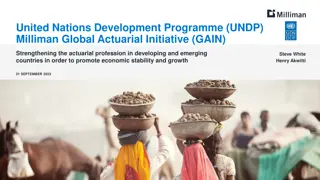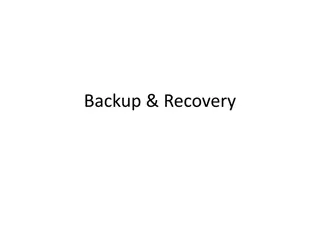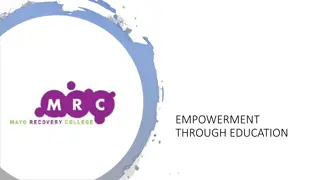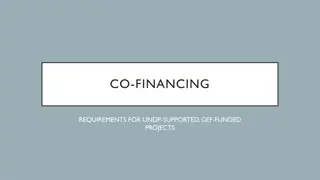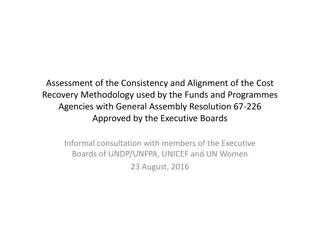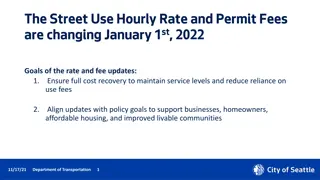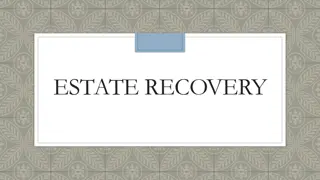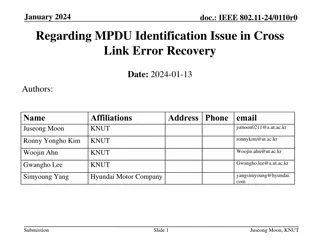Report on Effective Cost Recovery Rates by UNDP for 2014-2017
The joint report on cost recovery by UNDP for the years 2014-2017 provides detailed evidence and analysis of the effective average cost recovery rates, compliance with cost recovery policy, and calculations based on financial information. The report highlights contributions from various sources, including programme country governments, to offset local office costs, and outlines the calculation methodology for cost recovery rates across different funding streams.
Download Presentation

Please find below an Image/Link to download the presentation.
The content on the website is provided AS IS for your information and personal use only. It may not be sold, licensed, or shared on other websites without obtaining consent from the author. Download presentation by click this link. If you encounter any issues during the download, it is possible that the publisher has removed the file from their server.
E N D
Presentation Transcript
Annexes to DP/FPA-ICEF-UNW/2018/1 Joint report on cost recovery
ANNEX 1 ANNEX 1 Evidence based on financial information from 2014-2017 actuals
Annex 1A [UNDP] Table 1 - Effective average cost recovery rate for 2014-2017 in millions of US dollars Effective average cost recovery rate: 6.1% 6.3% 2014 2015 2016 2017 2014-2017 6.4% 6.1% 6.2% Notes: 1.All amounts from Atlas GL in line with UNDP audited Financial Statements for 2014, 2015 and 2016, and unaudited Financial Statements for 2017. 2.Note that in calculation of the effective average cost recovery rate, the denominator is adjusted for $34.3m for 2014, $38.5m for 2015 and $45.4m for 2016 to take into account GEF/Montreal Protocol related accounting. 3.Programme country governments also contribute to offset local office costs through cash as well as in-kind contributions. The effective average cost recovery rate is calculated as: Total Cost recovery revenue divided by (Total non-core programme expenses less Total Cost recovery revenue)
Annex 1A [UNDP] Table 2 Effective average cost recovery rates by funding stream Effective average cost recovery rate: 6.1% 6.3% 2014 2015 2016 6.4% 6.1% 2017 The effective average cost recovery rate is calculated as follows: Total Cost recovery revenue ______________________ (Total non-core programme expenses less Total Cost recovery revenue) Note: * Programme country governments also contribute to offset local office costs through cash as well as in-kind contributions. 4
Annex 1A [UNDP] Table 3 - UNDP Calculation of rate in line with approved formula in documents 2014-2017 DP-FPA/2013/1 E/ICEF/2013/8 (*) Based on data reported in UNDP ARFS for 2014, 2015 and 2016 in annexes 1&2, net of GLOC and in-kind contributions. 2017 data based on unaudited financial information. 5
ANNEX 1A [UNDP] ANNEX 1A [UNDP] Table 4 Table 4 UNDP compliance with cost recovery policy UNDP compliance with cost recovery policy 2014-2017 Core Non-core Delivery (basis for calculation of actual cost recovery charged) A $2,008 $15,255 Actual cost recovery charged (see slides for details on non-core) B $106 $895 % (=B / [A - B]) 5.6% 6.2% C EB approved Transitionary measures $199 $199 Total actual cost recovery including Transitionary measures D = B + C $305 $1,094 E Critical cross cutting management functions ('CCCM') $163 - F = D + E Total (including Transitionary measures and CCCM) % of non-core delivery $468 $1,094 7.62% * Based on financial information reported in UNDP's audited financial statements and annual financial reports for 2014, 2015, 2016 and unaudited financial statements for 2017. Notes: $468m in core total expenditure under F reconciles with total UNDP core expenditure on management activities plus capital investments. 6
Annex 1B [UNFPA] Table 1 Effective Cost recovery rate, and impact of differentiated rates, legacy and waivers vs. the standard rate Effective rates Variance vs. standard 8% rate IC category 2014 2015 2016 2017 2014 2015 2016 2017 IC waiver approved 5.20% 5.19% 6.71% 6.66% 123,685 180,210 74,270 179,213 Legacy agreements Programme Country Standard (8% IC) Thematic Trust Funds Various umbrella agreements - EC, UN Pooled / Harmonized Total 7% 5% 8% 7% 7% 5% 8% 7% 7% 5% 8% 7% 7% 5% 8% 7% 1,898,992 901,586 452,914 1,505,532 646,242 682,321 1,305,214 279,870 534,167 1,239,938 113,461 832,741 - - - - 7% 7% 7% 7% 999,231 1,204,582 1,303,275 1,135,078 7.07% 7.10% 7.27% 7.33% 4,376,408 4,218,887 3,496,796 3,500,431 Note: Variance vs. the standard rate represents the difference between the effective cost recovery received and the cost recovery that would have been earned using the standard approved rate of 8%. Thus the amount is not exactly the same when comparing the effective cost recovey received to the notional rate derived by applying the approved methodology. Also excluded are IC recorded for the JPO programme and ePAS as the IC is not credited to the Institutional Budget. 7
Annex 1B [UNFPA] Table 2 UNFPA Calculation of rate in line with approved formula in documents 2014-2017 DP-FPA/2013/1 E/ICEF/2013/8 Calculation of Rate based on Approved Methodology 2014-2017 (in US$ Million) - UNFPA Actual Expenses Use of resources Regular resources (RR) Other resources (OR), gross (A) (expenditures subject to cost recovery) 2014 2015 2016 2017 Total 2014-2017 A1 A2 445.0 512.2 957.1 420.3 502.2 922.6 361 317 1,543 508 572 2,094 868.8 Total 888.6 3,637.1 1. Calculate the proportionate percentage share of RR and OR in the planned use of resources Proportionate share RR Proportionate share OR (B) B1 B2 46% 54% 46% 54% 42% 58% 36% 64% 42% 58% 2. Calculate the sum of management and comparable Special Purpose costs [and remove costs related to critical, cross-cutting functions) C Institutional Budget Less Development Effectiveness Activities Non-Comparable Special purpose Activities UN Development Coordination Activities Critical cross-cutting management functions based on standard costs 139.5 140.3 136.8 141.5 558.1 C1 C2 C3 C4 (30.4) (31.1) (30.7) (29.7) (122.0) (2.0) (38.3) (2.1) (37.9) (2.2) (2.3) (8.6) (37.1) (37.8) (151.0) 3. Take the amount calculated in step 2. and split it proportionally according to the levels of total planned core and non-core use of resources D=C-(C1:C4) Institutional Budget Subject to Cost Recovey based on approved methodology E1=B1*D Regular Resources Proportional Share of IB E2=B2*D Other Resources Proportional Share of IB F=E2/(A2-E2) Notional Rate 68.9 69.2 66.7 71.7 276.5 32.0 31.5 36.9 37.7 7.76% 8.11% 27.7 39.0 8.32% 25.5 46.1 8.77% 117.3 159.7 8.25% G H=G/(A2-G) Cost Recovery actually earned Effective Rate 33.8 7.07% 33.3 7.10% 34.4 7.27% 39.0 7.33% 140.6 7.19% 8
Annex 1C [UNICEF] Table 1 UNICEF Calculation of rate in line with approved formula in documents 2014-2017 DP-FPA/2013/1 E/ICEF/2013/8 9
Annex 1D [UN Women] Table 1 UN WOMEN Calculation of cost recovery rate in line with approved formula in documents- 2014-2017 Actual Expenses Actuals (use of resources per Financial Statements 2014, 2015, 2016 and est 2017) 2014 2015 2016 * 2017 Total 2014-2017 576.0 690.4 1266.4 A1 A2 Regular resources Other resources (gross) Total 143.0 131.0 274 149.0 142.4 168.9 201.5 318 141.6 189.0 330.6 344 1. Calculate the proportionate percentage share of RR and OR in the planned use of resources Proportionate share RR Proportionate share OR B1 B2 52% 48% 47% 53% 41% 59% 43% 57% 45% 55% 2. Calculate the sum of management and comparable Special Purpose costs [and remove costs related to critical, cross-cutting functions) C Institututional Budget Less Development Effectiveness Activities Non-Comparable Special purpose Activities UN Development Coordination Activities Critical cross-cutting functions based on standard costs 73.0 82.5 78.5 75.5 309.5 C1 C2 C3 C4 (21.3) (23.4) (21.2) (17.5) (83.4) (10.4) (18.5) (12.4) (21.0) (12.2) (22.4) (12.0) (22.4) (47.0) (84.2) 3. Take the amount calculated in step (i) and split it proportionally according to the levels of total planned D= C-(C1:C4) Institutional Budget Subject to cost recovery based on approved methodology E1=B1*D Regular Resources Proportional share of IB E2=B2*D Other Resources Proportional Share of IB F=E2/(A2-E2) Notional cost recovery rate 22.8 11.9 10.9 8.3% 25.7 12.0 13.7 8.1% 22.8 9.4 13.4 6.6% 23.7 10.1 13.5 7.2% 95.0 43.2 51.8 7.5% G H=G/(A2-G) * 2017 estimated until books are closed. Cost recovery actually earned Effective Rate 10.3 7.12% 7.00% 7.14% 7.25% 11.5 12.6 13.9 48.3 7.13%
ANNEX 2 ANNEX 2 Evidence based on 2018-2019/2021 EB approved integrated budgets
ANNEX 2A UNDP table 1 BACKGROUND SCENARIO - Comparison current vs. potential adjusted methodology(in US$ Million) - UNDP - based on 2018-2019 Use of resources Current Model (per decision 2013/9) Modular 'LEGO' approach - LEGO A Modular 'LEGO' approach - LEGO B A1 A2 Regular resources (RR) Other resources (OR), gross (A) Total 1,353 10,320 11,673 1,353 10,320 11,673 1,353 10,320 11,673 1. Calculate the proportionate percentage share of RR and OR in the planned use of resources B1 B2 Proportionate share RR Proportionate share OR (B) 12% 88% 12% 88% 12% 88% 2. Calculate the sum of management and comparable Special Purpose costs [and remove costs related to critical, cross-cutting functions) C Institutional Budget Less Development Effectiveness DE breakdown: Core funded $95 and Cost recovery funded $153 Non-Comparable Special purpose Activities (core funded) Non-Comparable Special purpose Activities (other un agency / external party reimbursable services) UN Development Coordination Activities Critical cross-cutting management functions based on standard costs 1,286 1,286 1,286 C1 C1 - a C1 - b C2 - a C2 - b C3 C4 (248) (22) (112) (161) (90) Agency specific area: reimbursable support to other UN agencies (112) (112) Agency specific area: RC system support (161) (161) (22) Agency specific areas: support to UNV/UNCDF CO leadership - LEGO A has 2 Leadership posts for all Cos; no operations.; LEGO B has 2 lead for large and 1 lead for medium/small COs (excluding RC part which is embedded above) and including operations leadership; Executive leadership Independent assurance (22) C5 (113) (122) (8) (4) (16) (45) (366) 7.4% (69) 6.8% (98) (533) subtotal 'green' (308) 8.0% (52) 7.5% Notional rate if only block 1 is protected Directing advocacy, resource stewardship and technical leadership Notional rate if block 1 and 2 are protected Integration professional standards, norms and quality assurance Total functions protected using Core (regular) resources C6 C7 (53) (367) (413) 3. Take the amount calculated in step 2. and split it proportionally according to the levels of total planned core and non-core use of resources Institutional Budget Subject to Cost Recovery Regular Resources Proportional Share of IB Other Resources Proportional Share of IB Notional rate if block 1, 2 and 3 are protected D = C - [C1-C8) E1 = B1 * D E2 = B2 * D F = E2/[A2-E2] 654 641 761 76 578 5.9% 74 567 5.8% 88 673 7.0% Development effectiveness (DE) activities comprise: programme level activities, (e.g. programme design and formulation, programme Q.A., formulation and management of programme pipeline); and project level activities (e.g. programme policy advisory services) The current model excludes all abovementioned DE activities from the calculation of the cost recovery rate. In the Modular LEGO approach, programme level DE activities are proposed to be funded through regular resources funded LEGO blocks plus cost recovery; and project level DE activities are to be funded directly by the related projects.
Annex 2A Annex 2A UNDP UNDP application of application of lego lego blocks (including differences between option A and B) (*) blocks (including differences between option A and B) (*) Block Description Option A: Takes into account full cost of the functions which are included in LEGO building blocks . Option B: Focus is on leadership(**) (green and yellow LEGO blocks) and on country facing activities (blue LEGO block). Remaining functions are proportionally covered through indirect cost recovery. Executive Office, Ethics Office and Ombudsman Fully covered by regular resources Only leadership posts (fully loaded cost of D1 and higher graded positions), plus UNDP contribution to Ombudsman office, are fully covered by regular resources. Executive leadership, Country Office leadership, Independent Assurance Independent corporate oversight and assurance Internal and external audit and investigation Evaluation Fully covered by regular resources Only leadership posts (fully loaded cost of D1 and higher graded positions plus P5 unit chiefs) are fully covered by regular resources. Posts of Representative (CD, where applicable) and Deputy Representative (or national equivalent) (***) 2 Senior positions for all COs are fully covered by regular resources (***) 2 Senior positions for large COs, and 1 senior position for medium/small COs, including operations leadership fully covered by regular resources Support to UN Development Coordination Support to UNV and UNCDF Fully covered by regular resources Fully covered by regular resources Leadership of management functions at HQ and Regional Office levels: Fiduciary, IT, Human Resources, Partnerships and Security management functions Fully covered by regular resources Only leadership posts (fully loaded cost of D1 and higher graded positions) are fully covered by regular resources. Directing advocacy, resource stewardship and technical leadership Leadership of development effectiveness functions at HQ and Regional Office levels: Technical leadership, programmatic policy and support for norm setting functions Fully covered by regular resources Only leadership posts (fully loaded cost of D1 and higher graded positions) are fully covered by regular resources. Remaining development effectiveness functions: Integration of professional standards and quality assurance Programme-policy advisory functions Fully covered by regular resources Only positions that provide country level support, as well as country- facing programme policy advisory support, including south-south cooperation are covered by regular resources Integrating professional standards, norms and quality assurance (*) Coverage of positions under both options A and B relates to post plus related non-post costs. (**) Leadership sets the direction, is responsible for executive management, inter-bureaux and inter-agency coordination, reporting to the Executive Board, research and innovation, partnerships, oversight and assurance, fiduciary functions and operations. Leadership also spearheads the policy, planning and overall management in the respective functional areas for each organization. Leadership ensures that UN norms and standards are integrated across all areas of work. (***) Represents the RR portion of the cost of positions, whereas the RC portion is covered under support to UN Development Coordination. For option B, this covers the financial equivalent of the fully loaded cost of Resident Representative positions in all LICs/MICs plus a pool of regular resources for operations leadership. 13
Comparison current vs. potential adjusted methodology based on 2018-2021 budget (in US$ Million) - UNFPA Current model, Modular LEGO A, and Modular LEGO B Use of resources Annex 2B UNFPA table 1 Current Model (per decision 2013/9) Modular 'LEGO' approach - LEGO A Modular 'LEGO' approach - LEGO B A1 A2 Regular resources (RR) Other resources (OR), gross (A) Total 1. Calculate the proportionate percentage share of RR and OR in the planned use of resources Proportionate share RR Proportionate share OR (B) 2. Calculate the sum of management and comparable Special Purpose costs [and remove costs related to critical, cross-cutting functions) Institutional Budget Less Development Effectiveness Activities Non-Comparable Special purpose Activities UN Development Coordination Activities Critical cross-cutting management functions based on standard costs Subtotal protected functions Notional rate Agency specific areas (RC system support, support to other agencies) Non-Comparable Special purpose Activities Country Office leadership Executive leadership Independent Assurance Subtotal protected functions for block 1 (green) Notional rate if only block 1 is protected Non-CO (ie HQ + RO) leadership (+ 30% GOE for harmonized management functional clusters: Corp HR, Corp External relations & Partnership; Security; Corp Finance, ICT etc; Field Oversight, Management, support) 1,392.3 2,194.1 3,586.4 1,392.3 2,194.1 3,586.4 1,392.3 2,194.1 3,586.4 B1 B2 39% 61% 39% 61% 39% 61% C 708.4 708.4 708.4 C1 C2 C3 C4 (141.0) (20.0) (9.4) (174.8) (345.2) 11.3% C5 (9.4) (20.0) (186.8) (26.6) (45.9) (288.6) 13.3% (49.3) (9.4) (20.0) (186.8) (12.0) (45.9) (274.1) 13.8% (49.3) C6a C6b Leadership at HQ and RO level for DE functions (+ 30% GOE) Subtotal protected functions for block 1 and block 2 (green + yellow) Notional rate if blocks 1 & 2 are protected Integrating professional standards, norms and quality assurance (28.0) (365.9) 10.6% (48.8) (28.0) (351.3) 11.1% (46.3) C7 C8=(C1:C7) Total protected functions for blocks 1+2+3 (green+yellow+blue) Notional rate if blocks 1, 2 & 3 are protected (345.2) 11.3% (414.7) 8.9% (397.6) 9.5% 3. Take the amount calculated in step 2. and split it proportionally according to the levels of total planned core and non-core use of resources (cumulative) D=C-(C1:C7) Institutional Budget Subject to Cost Recovey based on approved methodology E1=B1*D Regular Resources Proportional Share of IB E2=B2*D Other Resources Proportional Share of IB F=E2/(A2-E2) Notional Rate for block1, block 2, and block 3 363.2 293.7 310.8 141.0 222.2 11.3% 114.0 179.7 8.9% 120.6 190.1 9.5%
Annex 2B UNFPA application of lego blocks (including differences between option A and B) Block Description Option A Option B Block 1: Executive leadership, Country Office leadership, Independent Assurance Executive Office, Ethics and Ombudsman Fully covered by regular resources Only leadership posts (+30% GOE), plus UNFPA contribution to Ombudsman office, are fully covered by regular resources. Remaining functions are proportionally covered through indirect cost recovery. Independent corporate oversight and assurance * Internal and external audit and investigation * Evaluation Fully covered by regular resources Fully covered by regular resources Posts of Representative and Deputy Representative (or national equivalent) Fully covered by regular resources Fully covered by regular resources Support to UN Development Coordination Fully covered by regular resources Fully covered by regular resources Block 2: Directing advocacy, resource stewardship and technical leadership Leadership of management functions at HQ and RO levels: Fiduciary, IT, Human Resources, Partnerships and Security management functions Fully covered by regular resources Fully covered by regular resources Leadership of development effectiveness functions at HQ and RO levels: technical leadership, programmatic policy and support for norm setting functions Fully covered by regular resources Fully covered by regular resources Block 3: Integrating professional standards, norms and quality assurance Remaining development effectiveness functions: * Integration of professional standards and quality assurance * Programme-policy advisory functions Fully covered by regular resources Substantive functions (international professional positions +30% GOE) in headquarters and regional offices covered by regular resources Remaining functions in headquarters and regional offices covered proportionally through indirect cost recovery
Annex 2C UNICEF table 1 Use of resources Current Model (per decision 2013/9) Modular 'LEGO' approach - LEGO A Modular 'LEGO' approach - LEGO B A1 A2 Regular resources (RR) Other resources (OR), gross (A) Total 6,420.3 17,550.6 23,970.9 6,420.3 17,550.6 23,970.9 6,420.3 17,550.6 23,970.9 1. Calculate the proportionate percentage share of RR and OR in the planned use of resources B1 B2 Proportionate share RR Proportionate share OR (B) 27% 73% 27% 73% 27% 73% 2. Calculate the sum of management and comparable Special Purpose costs [and remove costs related to critical, cross-cutting functions) C Institutional Budget Less Development Effectiveness Activities Non-Comparable Special purpose Activities UN Development Coordination Activities Critical cross-cutting management functions based on standard costs 2,455.5 2,455.5 2,455.5 (721.9) 0.0 (49.3) (202.1) C1 C2 C3 C4 Agency specific areas (RC system support, support to other agencies (23.3) (23.3) Non Comparable Special Purpose CO Leadership Corporate Leadership and Direction Corporate Oversight and Assurance subtotal protected functions for Block 1 'green' Notional Rate if only Block 1 is protected - C5 (339.0) (15.0) (14.3) (391.6) 9.4% (339.0) (37.2) (47.8) (447.3) 9.1% Directing advocacy, resource stewardship and technical leadership Notional Rate if Blocks 1 and 2 are protected C6 (88.9) 8.7% (88.9) 9.0% C7 Integration professional standards, norms and quality assurance (438.8) (377.1) Total functions protected for Blocks 1,2 and 3 using Core (regular) resources Notional Rate if Blocks 1, 2 and 3 are protected (973) (975.0) 6.6% (857.6) 7.1% 3. amount calculated in step 2, split proportionally per levels of total planned core and non-core use of resources Institutional Budget Subject to Cost Recovery Regular Resources Proportional Share of IB Other Resources Proportional Share of IB Notional Rate D = C - [C1-C8) E1 = B1 * D E2 = B2 * D F = E2/[A2-E2] 1,482.2 1,480.5 1,597.9 397.0 1,085.2 6.6% 396.5 1,084.0 6.6% 428.0 1,169.9 7.1%
Annex 2C UNICEF application of lego blocks (including differences between Option A and Option B) Block Description Option A Option B Block 1: Executive leadership, Country Office leadership, Independent Assurance Executive Office, Ethics and Ombudsman Executive and Ethics Offices fully covered by regular resources. Leadership posts (+30% GOE), plus 40% of UNICEF contribution to Ombudsman office, are fully covered by regular resources. Remaining functions are proportionally covered through indirect cost recovery. Independent corporate oversight and assurance * Internal and external audit and investigation * Evaluation Fully covered by regular resources Only leadership posts (+30% GOE) are fully covered by regular resources. Remaining functions are proportionally covered through indirect cost recovery. Posts of Representative and Deputy Representative (or national equivalent) Fully covered by regular resources Fully covered by regular resources Support to UN Development Coordination Fully covered by regular resources Fully covered by regular resources Block 2: Directing advocacy, resource stewardship and technical leadership Leadership of management functions at HQ and RO levels: Fiduciary, IT, Human Resources, Partnerships and Security management functions All Critical Recurring senior management functions fully covered by regular resources Critical Recurring senior management functions (+30% GOE) fully covered by regular resources. Remaining functions are proportionally covered through indirect cost recovery Leadership of development effectiveness functions at HQ and RO levels: technical leadership, programmatic policy and support for norm setting functions All HQ and RO senior management functions fully covered by regular resources Critical Recurring senior management functions (+30% GOE) fully covered by regular resources Remaining functions are proportionally covered through indirect cost recovery Block 3: Integrating professional standards, norms and quality assurance Remaining development effectiveness functions: * Integration of professional standards and quality assurance * Programme-policy advisory functions Fully covered by regular resources Substantive functions (international professional positions +30% GOE) in headquarters and regional offices covered by regular resources Remaining functions in headquarters and regional offices covered proportionally through indirect cost recovery
Annex 2D - UN Women BACKGROUND SCENARIO - Comparison current vs. potential adjusted methodology(in US$ Million) - UN Women based on 2018-2019 Use of resources Current Model (per decision 2013/9) Modular 'LEGO' approach - LEGO A Modular 'LEGO' approach - LEGO B A1 A2 Regular resources (RR) Other resources (OR), gross (A) Total 400.0 480.0 880.0 400.0 480.0 880.0 400.0 480.0 880.0 1. Calculate the proportionate percentage share of RR and OR in the planned use of resources B1 B2 Proportionate share RR Proportionate share OR (B) 45% 55% 45% 55% 45% 55% 2. Calculate the sum of management and comparable Special Purpose costs [and remove costs related to critical, cross-cutting functions) C Institutional Budget Less Development Effectiveness Activities Non-Comparable Special purpose Activities UN Development Coordination Activities Critical cross-cutting management functions based on standard costs 201.8 201.8 201.8 C1 C2 C3 C4 (50.1) (3.0) (27.2) (45.9) Agency specific areas (RC system support, support to other agencies (27.2) (3.0) (27.2) Non Comparable Special Purpose CO Leadership Corporate Leadership and Direction Corporate Oversight and Assurance (3.0) (26.6) (4.7) (12.7) (74.2) 17.0% (27.9) 12.8% C5 (26.6) (6.5) (12.7) (76.0) 16.7% (27.9) 12.5% (28.4) (132.3) 8.6% subtotal protected functions for Block 1 'green' Notional rate if blcok 1 is protected Directing advocacy, resource stewardship and technical leadership Notional rate if Block 1 and 2 are protected Integration professional standards, norms and quality assurance Total functions protected for Blocks 1,2 and 3 using core (regular) resources C6 C7 (23.3) (126) 9.4% (125.4) 9.5% Notional Rate if Blocks 1,2 and 3 are protected 3. amount calculated in step 2, split proportionally per levels of total planned core and non-core use of resources Institutional Budget Subject to Cost Recovery Regular Resources Proportional Share of IB Other Resources Proportional Share of IB Notional Rate D = C - [C1-C8) E1 = B1 * D E2 = B2 * D F = E2/[A2-E2] 75.6 69.5 76.4 34.4 41.2 9.4% 31.6 37.9 8.6% 34.7 41.7 9.5%
Annex 2D - UN Women application of lego blocks (including differences between Option A and Option B) UN WOMEN application of lego blocks (including differences between Option A and Option B) Block Description Option A Option B Block 1: Executive leadership, Country Office leadership, Independent Assurance Corporate leadership support to the Executive Office Fully covered by regular resources. Covered by regular and indirect resources Posts of Representative, Country Director (or national equivalent), Fully covered by regular resources Fully covered by regular resources Support to UN Development Coordination Fully covered by regular resources Fully covered by regular resources Independent corporate oversight and assurance * Internal Audit Office * Evaluation Fully covered by regular resources Fully covered by regular resources Block 2: Directing advocacy, resource stewardship and technical leadership Leadership of management functions at HQ and RO levels: Fiduciary, IT, Human Resources, Partnerships and Security management functions Fully covered by regular resources Fully covered by regular resources Leadership of development effectiveness functions at HQ and RO levels: technical leadership, programmatic policy and support for norm setting functions Fully covered by regular resources Fully covered by regular resources Block 3: Integrating professional standards, norms and quality assurance Remaining development effectiveness functions: * Integration of professional standards and quality assurance * Programme-policy advisory functions Fully covered by regular resources International Professional Posts at HQ and RO covered by regular resources and all others by indirect cost recovery
ANNEX 3 ANNEX 3 Summary of evidence based on 2018- 2019/2021 EB approved integrated budgets
Annex 3 Annex 3 Table 1 Table 1 - - High level financial implications of the application of each proposal for each agency High level financial implications of the application of each proposal for each agency In US$ millions In US$ millions- - UNDP (2018-2019) UNICEF (2018-2021) UNFPA (2018-2021) UN Women (2018-2019) LEGO option B LEGO option B LEGO option B LEGO option B LEGO option A LEGO option A LEGO option A LEGO option A Application of LEGO blocks to UNDP business model Application of LEGO blocks for UNICEF business model Application of LEGO blocks for UNFPA business model Application of LEGO blocks for UN Women business model Current model Current model Current model Current model (per Jan/18 presentation to EB) (per Jan/18 presentation to EB) (per Jan/18 presentation to EB) (per Jan/18 presentation to EB) A: Regular resources $1,353m - 12% $1,353m - 12% $1,353m - 12% $6,420.3m - 27% $6,420.3m - 27% $6,420.3m - 27% $1,392.3m - 39% $1,392.3m - 39% $1,392.3m - 39% $400m - 45% $400m - 45% $400m - 45% B: Other resources $10,320m - 88% $10,320m - 88% $10,320m - 88% $17,550.6m - 73% $17,550.6m - 73% $17,550.6m - 73% $2,194.1m - 61% $2,194.1m - 61% $2,194.1m - 61% $480m - 55% $480m - 55% $480m - 55% C: Cost of functions protected by regular resources $367m $533m $413m $814.5m $975.1m $857.6m $345.2m $414.7m $397.6m $126.2 (Core) $132.3m (Core) $125.4 (Core) D: Notional cost recovery rate 5.9% 5.8% 7.0% 6.6% 6.6% 7.1% 11.3% 8.9% 9.5% 9.4% 8.6% 9.5% E: Cost recovery from regular resources using notional rate $76m $74m $88m $397.0m $396.5m $428.0m $141.0m $114.0m $120.6m $34.4m $31.6m $34.7m $910m $746m $852m $4,243.8m $4,083.6m $4,169.7m $906.1m $863.6m $874.0m $239.4m $236.1m $239.9m F: Regular resources available for programmatic component [67.3% of total] [55.1% of total] [63.0% of total] [66.0% of total] [63.6% of total] [65.0% of total] [65.1% of total] [62.0% of total] [62.8% of total] [59.9% of total] {59.0% of total) [60.0% of total] 21
Annex 3 Annex 3 Table 2A. Annualized Table 2A. Annualized subsidy In US$ millions In US$ millions subsidy between regular and other resources for each proposal vs. current cost recovery rate between regular and other resources for each proposal vs. current cost recovery rate Table 2A proposed format - annualized calculation - relative subsidy between non-core to core resources vs an 8% cost recovery rate A. Calculations for each agency separately A. Calculations for each agency separately UNDP UNICEF UNFPA UN Women LEGO option B LEGO option A LEGO option A LEGO option A LEGO option B LEGO option B LEGO option B LEGO option A Application of LEGO blocks for UN Women business model Current model Application of LEGO blocks to UNDP business model Current model Application of LEGO blocks for UNICEF business model Current model Application of LEGO blocks for UNFPA business model Current model (per Jan/18 presentation to EB) (per Jan/18 presentation to EB) (per Jan/18 presentation to EB) (per Jan/18 presentation to EB) A: Notional cost recovery rate 5.9% 5.8% 7.0% 6.6% 6.6% 7.1% 11.3% 8.9% 9.5% 9.4% 8.6% 9.5% B: Cost recovery from other resources with the notional cost recovery rate $289 $283 $336 $271 $271 $292 $56 $45 $48 $21 $19 $21 C: Cost recovery from other resources with an 8% cost recovery rate $382 $382 $382 $325 $325 $325 $41 $41 $41 $18 $18 $18 Subsidy from other resources to regular resources D: (C - B) Difference in cost recovery between the notional cost recovery rate and an 8% cost recovery rate $93 $99 $46 $54 $54 $33 Subsidy from regular resources to other resources ($15) ($4) ($7) ($3) ($1) ($3) E: for reference - annualized size of the organization (total regular and other resources) $5,837 $5,837 $5,837 $5,993 $5,993 $5,993 $897 $897 $897 $440 $440 $440 22
Annex 3 Annex 3 Table 2B. Annualized Table 2B. Annualized subsidy In US$ millions In US$ millions subsidy between regular and other resources for each proposal vs. current cost recovery rate between regular and other resources for each proposal vs. current cost recovery rate B. Calculations for the four agencies combined as a total B. Calculations for the four agencies combined as a total Current model LEGO option A LEGO option B Net subsidy (from other to regular resources) $129 $148 $69 For reference - annualized size of the four agencies combined (total regular and other resources) $13,166 $13,166 $13,166 23


